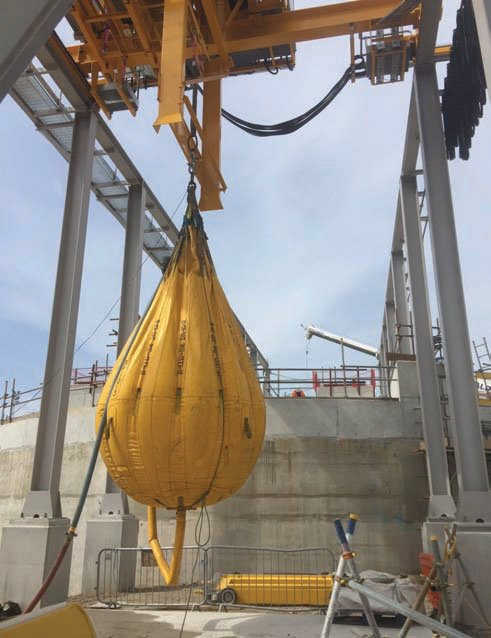Using water bags to cleverly complete the load test of a 5-ton bridge crane
Regarding the method of using water bags to load test overhead cranes, we have introduced it in the article Crane Manufacturer Watching Customers Test Overhead Cranes On Site?. Using a water bag for load testing has unique advantages, which are even more obvious in the case to be analyzed today. The project took place at a waterworks site in a tunnel in east London, UK.

Load testing process of overhead crane using water bags
The crane installation, located at Tunnel Thames Water Site 4. This was positioned above the main tunnel shaft at the major infrastructure project and will utilise 80m height of lift and 37m travel to remove debris from beneath.
It uses hydration bladders to create 10% and 25% overload conditions, gradually filling the hydration bladder to achieve the desired weight. Graham Dawson, warehouse manager at the London office, explains: “We considered using board weights to complete the test, but access to the area was restricted by the trench being dug, so that ruled it out as a viable solution. Additionally, transporting board weights was The cost and environmental impact are far greater than a water bag mounted on a pallet.”
“As the crane was newly installed, electrical issues arose on the first day. These were corrected before testing on the second day, but further on-site adjustments were required. The French representative requested that a static load be maintained for an hour to test the crane brakes, The UK department also wanted us to carry out deflection testing.” Calibrated 10-tonne load cells, shackles and slings were sourced from the crane manufacturer’s stock, while water weight packages were also hired. Following successful testing, the crane was handed over to Thames Water.

What can we learn from this
We often hear the saying that what is suitable is the best. When traditional load testing encounters problems, water bag testing perfectly solves the issues of cost and environmental impact. When we develop crane solutions for our customers, we often give more priority to applicability than our customers.
In addition to understanding the working conditions, we also need to have a detailed understanding of various technologies. If our knowledge reserve is not enough, we are likely to have deviations in the process of formulating strategies for customers. For example, in the water bag test, we need to know the advantages of using a water bag and why we use a water bag. Generally speaking, hydration bags can adapt to various environments and usage scenarios, including indoor and outdoor environments, as well as different climate conditions. Additionally, hydration bags can be customized as needed to meet specific load testing needs. However, water bags may be less stable during load testing than solid weights. Because the shape and weight distribution of the water bag may be affected by the flow and distribution of water, resulting in unstable test results. In practical applications, the advantages and disadvantages of using water bags for load testing need to be comprehensively considered based on specific circumstances to select the most suitable testing method.
